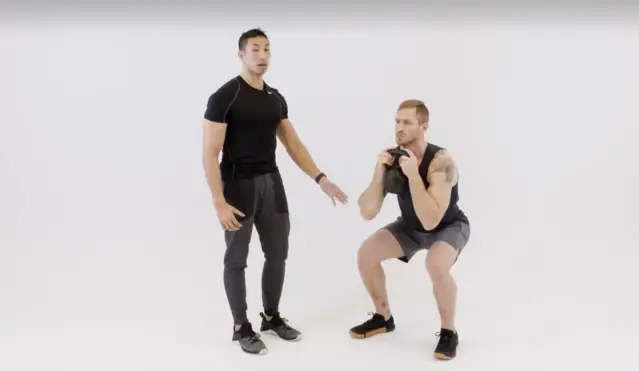The sumo squat dumbbell exercise is a compelling variation of the traditional squat exercise, known for its deeper engagement of the lower body muscles. By incorporating dumbbells and adopting a wider stance reminiscent of sumo wrestlers, this exercise not only intensifies strength-building in key muscle groups but also enhances flexibility and stability.
Here’s a closer look at the benefits of this exercise, the muscles it targets, and an example workout incorporating sumo squat dumbbells.
Benefits of Sumo Squat Dumbbell
- Enhanced Muscle Activation: The wider stance of the sumo squat increases muscle activation in the inner thighs and glutes compared to the traditional squat. This can lead to better muscle growth and strength in these areas.
- Improved Flexibility: The sumo squat requires a deeper descent, promoting greater hip flexibility. Regular practice can improve your range of motion, which is beneficial for other exercises and daily activities.
- Increased Stability and Balance: Holding a dumbbell adds an extra level of difficulty to the sumo squat. This challenges your core and lower body to maintain balance, thus enhancing overall stability.
- Versatility: This exercise can be modified in various ways (e.g., changing the weight of the dumbbell, adjusting the width of the stance) to cater to different fitness levels and goals.
- Convenience: Dumbbells are relatively inexpensive and accessible fitness tools that can be used at home or in the gym, making the sumo squat a practical addition to any workout routine.
READ MORE: 20 Amazing Things About Sumo Wrestling: Japan’s Grand Sport
Targeted Muscles
The sumo squat dumbbell focuses on several key muscle groups:
- Glutes: Due to the wide stance and squat depth, the glutes receive significant attention, aiding in strengthening and toning.
- Quadriceps: These front thigh muscles are heavily engaged as they work to extend the knee and support the body during the lift.
- Hamstrings: They assist in bending the knee and stabilizing the movement.
- Adductors (Inner Thighs): The sumo squat’s wide stance places more emphasis on the inner thighs than traditional squats.
- Core Muscles: Maintaining posture and balance during the exercise engages the abdominal and lower back muscles.
READ MORE: A Passion for Strength and Conditioning Education
Example Workout with Sumo Squat Dumbbell
Here’s a simple yet effective workout session incorporating sumo squat dumbbells, suitable for intermediate fitness enthusiasts:
Warm-Up
- 5 minutes of light cardio (jogging, cycling, or jumping jacks)
- Dynamic stretches focusing on the legs and hips
Workout
- Sumo Squat Dumbbell:
- Sets/Reps: 4 sets of 12-15 reps
- Instructions:
- Stand with your feet wider than shoulder-width apart, toes pointing slightly outward.
- Hold a dumbbell with both hands in front of you, arms extended downward.
- Keep your back straight and chest up as you lower into a squat, keeping the dumbbell slightly off the floor.
- Push through your heels to return to the starting position.
- Walking Lunges:
- Sets/Reps: 3 sets of 10 reps per leg
- Use dumbbells for added resistance.
- Plank:
- Duration: 3 sets of 30-60 seconds
- Focus on engaging the core throughout the hold.
Cool Down
- 5 minutes of light stretching, focusing on the legs, back, and hips.
READ MORE: 25 Facts About the Anterior Cruciate Ligament Injury, All You Need to Know
Conclusion
The sumo squat with a dumbbell is a robust exercise that builds strength, enhances flexibility, and improves stability. It targets multiple muscle groups, making it an efficient component of any strength training or fitness regimen. Whether you’re looking to enhance athletic performance, increase muscle tone, or improve functional movements in daily life, incorporating sumo squats into your routine can provide significant benefits. As always, consult with a fitness professional to ensure proper form and technique to maximize results and prevent injury.


